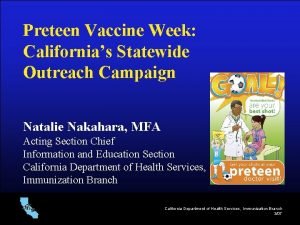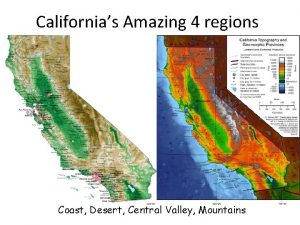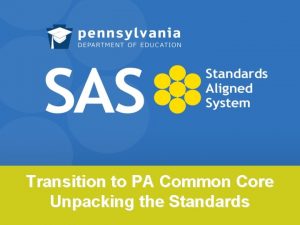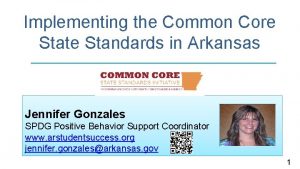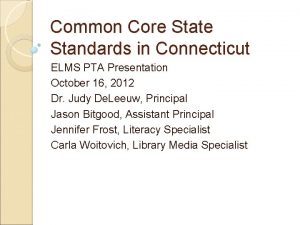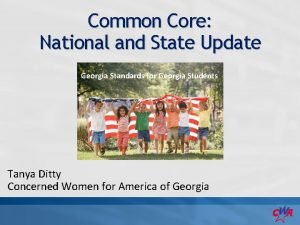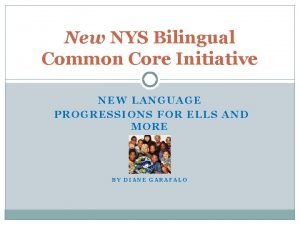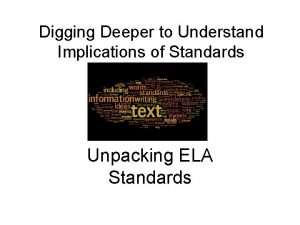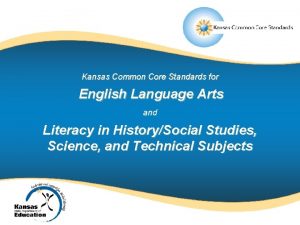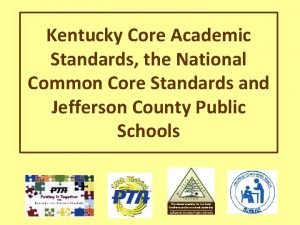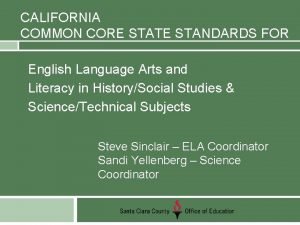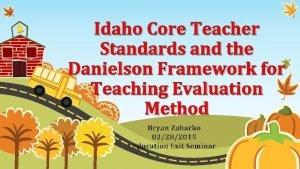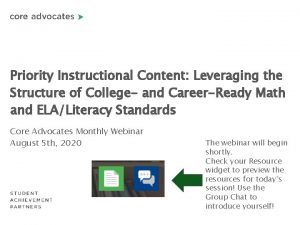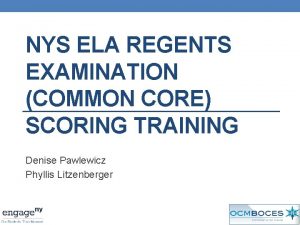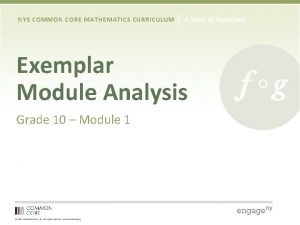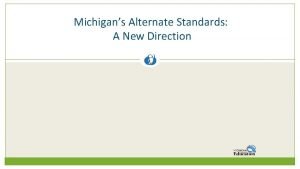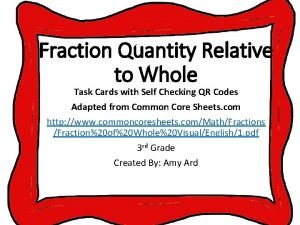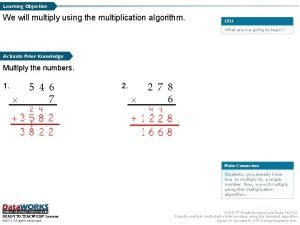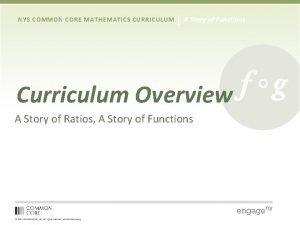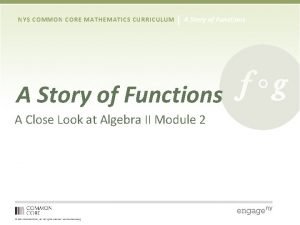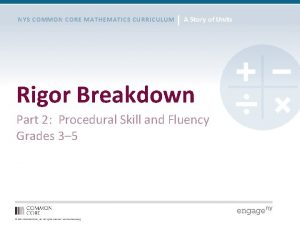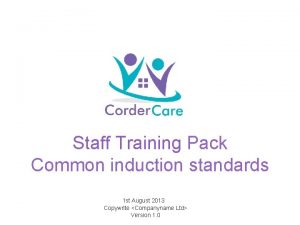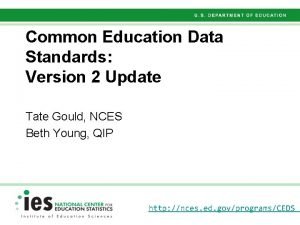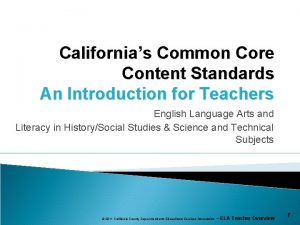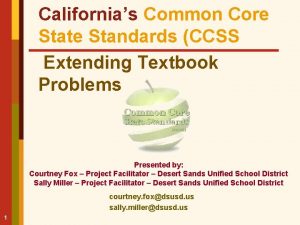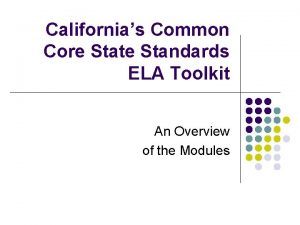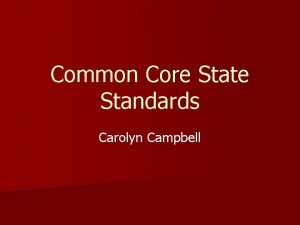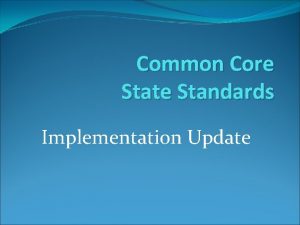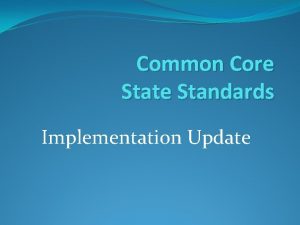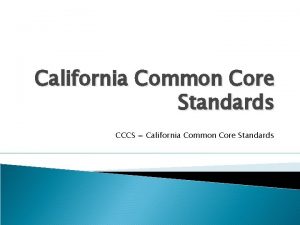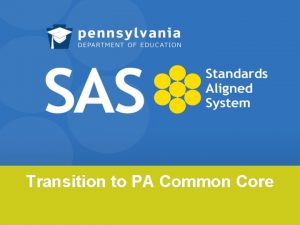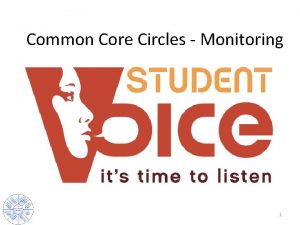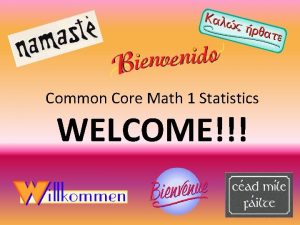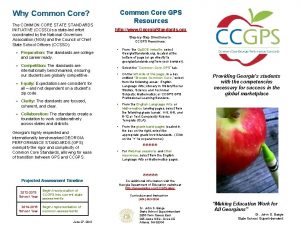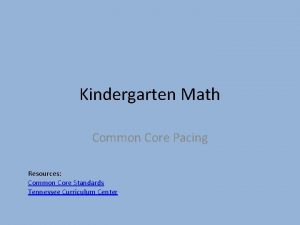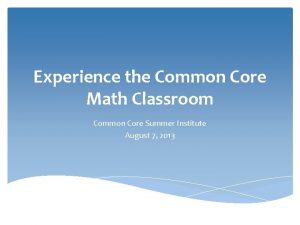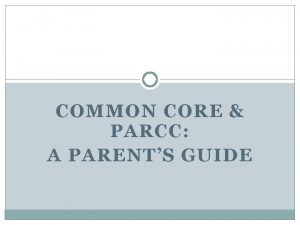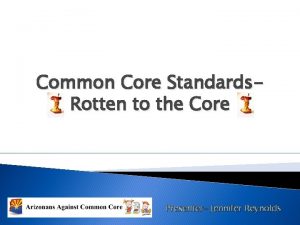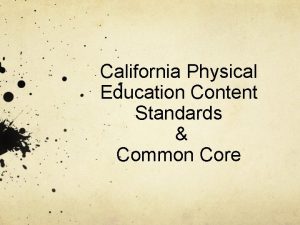Californias Common Core Content Standards An Introduction for


















































- Slides: 50

California’s Common Core Content Standards An Introduction for Teachers Mathematics © 2011 California County Superintendents Educational Services Association • Mathematics Teacher Overview 1

Objectives General Overview ◦ Focus and Coherence Structure ◦ Organization ◦ Mathematical Proficiency ◦ Grade 8 Options Similarities Shifts Next Steps © 2011 California County Superintendents Educational Services Association • Mathematics Teacher Overview 2

Common Core Standards Overview: Toward Greater Focus and Coherence Avoid the problem of “mile wide and an inch deep” Recognize that “fewer standards” are no substitute for focused standards Aim for clarity and specificity © 2011 California County Superintendents Educational Services Association • Mathematics Teacher Overview 3

Coherence Design Topics and performances are logical over time Based on learning progressions research on how students learn Reflect hierarchical nature of the content Evolve from particulars to deeper structures © 2011 California County Superintendents Educational Services Association • Mathematics Teacher Overview 4

Common Core Standards Define what students should understand be able to do in their study of mathematics ◦ Is the ability to justify appropriate to student’s math maturity ◦ Understanding and procedural skill are equally important and can be assessed using tasks of sufficient richness Are internationally benchmarked ◦ Reflect rigor, focus and coherence of standards in top-performing countries © 2011 California County Superintendents Educational Services Association • Mathematics Teacher Overview 5

Common Core Standards Do: ◦ Set grade-level standards K-8 ◦ Identify standards for Algebra 1 ◦ Provide conceptual cluster standards in high school ◦ Provide clear signposts along the way toward the goal of college and career readiness for all students © 2011 California County Superintendents Educational Services Association • Mathematics Teacher Overview 6

Common Core Standards Do not: ◦ Define intervention methods or materials ◦ Define the full range of supports for English learners, students with special needs and students who are well above or below grade level expectations ◦ Dictate curriculum or teaching methods © 2011 California County Superintendents Educational Services Association • Mathematics Teacher Overview 7

Common Core Standards for Mathematics: Two Types Mathematical Practice (recurring throughout the grades) Mathematical Content (different at each grade level) © 2011 California County Superintendents Educational Services Association • Mathematics Teacher Overview 8

Common Core Standards: Mathematical Proficiency Standards for Mathematical Practice ◦ Describe habits of mind of a mathematically expert student ◦ Relate to mathematical proficiency as defined by the California Framework © 2011 California County Superintendents Educational Services Association • Mathematics Teacher Overview 9

Mathematical Proficiency as defined by the California Framework “WHERE” THE MATHEMATICS WORK Problem Solving Computational & Procedural Skills DOING MATH Conceptual Understanding “HOW” THE MATHEMATICS WORK “WHY” THE MATHEMATICS WORK © 2011 California County Superintendents Educational Services Association • Mathematics Teacher Overview 10

Standards for Mathematical Practice… “ …describe ways in which developing student practitioners of the discipline of mathematics increasingly ought to engage with the subject matter as they grow in mathematical maturity and expertise throughout the elementary, middle and high schools years. ” © 2011 California County Superintendents Educational Services Association • Mathematics Teacher Overview 11

Standards for Mathematical Practice Mathematically proficient students: 1. Make sense of problems and persevere in solving them …start by explaining to themselves the meaning of a problem and looking for entry points to its solution 2. Reason abstractly and quantitatively …make sense of quantities and their relationships to problem situations 3. Construct viable arguments and critique the reasoning of others …understand use stated assumptions, definitions, and previously established results in constructing arguments 4. Model with mathematics …can apply the mathematics they know to solve problems arising in everyday life, society, and the workplace © 2011 California County Superintendents Educational Services Association • Mathematics Teacher Overview 12

Standards for Mathematical Practice Mathematically proficient students: 5. Use appropriate tools strategically …consider the available tools when solving a mathematical problem 6. Attend to precision …calculate accurately and efficiently 7. Look for and make use of structure …look closely to discern a pattern or structure 8. Look for and express regularity in repeated reasoning …notice if calculations are repeated, and look for both general methods and for shortcuts © 2011 California County Superintendents Educational Services Association • Mathematics Teacher Overview 13

Try It! Mathematical Practices Locate the Mathematical Practices With a partner compare the eight mathematical practices to the three components of a balanced math program as defined by the California Framework Which practices align best to Conceptual Understanding? Computation and Procedures? Problem Solving? Be ready to share out with the entire group. © 2011 California County Superintendents Educational Services Association • Mathematics Teacher Overview 14

Connecting Practices to Content Balanced combination of procedure and understanding “Understand” expectations connect practice to content. ◦ Lack of understanding prevents students from engaging in the mathematical practices ◦ Weighted toward central and generative concepts that most merit the time, resources, innovative energies and focus Build in complexity and provide more clarity for expected performance © 2011 California County Superintendents Educational Services Association • Mathematics Teacher Overview 15

Connecting Practices to Content: Example Grade One ◦ Understand Place Value ◦ The two digits of a two-digit number represent amounts of tens and ones ◦ 10 can be thought of as a bundle of ten ones – called a “ten. ” ◦ The numbers from 11 to 19 are composed of a ten and one, two, etc. ◦ The numbers 10, 20, 30, … refer to one, two, three, …tens and zero ones © 2011 California County Superintendents Educational Services Association • Mathematics Teacher Overview 16

Grade K-8 Standards Overview page ◦ Lists domains, clusters and mathematical practices Standards-by grade level ◦ Defines what students should understand be able to do Clusters ◦ Groups of related standards. Standards from different clusters may be closely related Domains ◦ Larger groups of related standards. Standards from different domains may be closely related. Additional standard language or whole standards ◦ Bolded and underlined ◦ Added to maintain rigor of California expectations © 2011 California County Superintendents Educational Services Association • Mathematics Teacher Overview 17

© 2011 California County Superintendents Educational Services Association • Mathematics Teacher Overview 18

K-8 Grade Section Overview Page © 2011 California County Superintendents Educational Services Association • Mathematics Teacher Overview 19

Grade 2 Example © 2011 California County Superintendents Educational Services Association • Mathematics Teacher Overview 20

Try It! Introducing the Standards Locate one grade level in your standards handout Find ◦ Introduction ◦ Domains ◦ Clusters ◦ Standards At your table, pick a grade level and have each person or partner group choose a domain and read. Share out reactions to language, content and structure. Share out with the large group. © 2011 California County Superintendents Educational Services Association • Mathematics Teacher Overview 21

California Comparison Common Core State Standards for CA DOMAINS California Standards • Grades K-7 STRANDS K-5 • Counting and Cardinality (K only) • Operations and Algebraic Thinking • Number and Operations in Base 10 • Number and Operations-Fractions • Measurement and Data • Number Sense 6 -8 • Ratio and Proportional Relationships (grade 6 -7) • The Number System • Expressions and Equations • Functions (Grade 8) • Geometry • Statistics and probability • Mathematical Reasoning • Algebra and Functions • Measurement and Geometry • Statistics, Data Analysis and Probability © 2011 California County Superintendents Educational Services Association • Mathematics Teacher Overview 22

© 2011 California County Superintendents Educational Services Association • Mathematics Teacher Overview 23

Ties Between Domains: Example © 2011 California County Superintendents Educational Services Association • Mathematics Teacher Overview 24

Try It! Trace across Domains Choose a domain that covers at least two grade levels and read the standards at each grade level. ◦ What do you notice? ◦ What big ideas are repeated Be prepared to share key findings with the group. © 2011 California County Superintendents Educational Services Association • Mathematics Teacher Overview 25

Develop Conceptual Understandings Solve addition and subtraction word problems, and add and subtract within 10, e. g. , by using objects or drawings to represent the problem. (K. OA. 2) Add and subtract within 1000, using concrete models or drawings and strategies based on place value, properties of operations, and/or the relationship between addition and subtraction; relate the strategy to a written method. Understand that in adding or subtracting three-digit numbers, one adds or subtracts hundreds and hundreds, tens and tens, ones and ones; and sometimes it is necessary to compose or decompose tens or hundreds. (2 NBT. 7) © 2011 California County Superintendents Educational Services Association • Mathematics Teacher Overview 26

Emphasis on Fluency Fluently multiply and divide within 100, using strategies such as the relationship between multiplication and division (e. g. knowing that 8 x 5 = 40, one knows 40 ÷ 5 = 8) or properties of operations. By the end of grade 3, know from memory all products of two one-digit numbers. (3. OA. 7) Fluently multiply multi-digit whole numbers using the standard algorithm. (5. NBT. 5) © 2011 California County Superintendents Educational Services Association • Mathematics Teacher Overview 27

A Strong Focus on Fractions Represent a fraction 1/b on a number line diagram by defining the interval from 0 to 1 as the whole and partitioning it into b equal parts. Recognize that each part has size 1/b and that the endpoint of the part based at 0 locates the number 1/b on the number line. (3. NF. 2. a) Solve word problems involving addition and subtraction of fractions referring to the same whole, including cases of unlike denominators, e. g. by using visual fraction models or equations to represent the problem. Use benchmark fractions and number sense of fractions to estimate mentally and assess the reasonableness of answers. For example, recognize an incorrect result 2/5+ 1/2 = 3/7, by observing that 3/7 < 1/2. (5. NF. 2) © 2011 California County Superintendents Educational Services Association • Mathematics Teacher Overview 28

Fraction Concepts ¶ Compare two fractions with the same numerator or the same denominator by reasoning about their size. Recognize that comparisons are valid only when the two fractions refer to the same whole. Record the results of comparisons with the symbols >, =, or <, and justify the conclusions, e. g. , by using a visual fraction model. ( 3. NF. 3 d) Discuss how you might compare pairs of fractions using a visual fraction model. For discussion purposes, use the following two fraction pairs: 7/9 and 4/9 (same denominator) 4/9 and 4/7 (same numerator) © 2011 California County Superintendents Educational Services Association • Mathematics Teacher Overview 29

Fraction Concepts Source: www. mathisfun. com/numbers/fraction-number-line. html © 2011 California County Superintendents Educational Services Association • Mathematics Teacher Overview 30

Fraction Concepts Source: www. mathisfun. com/numbers/fraction-number-line. html © 2011 California County Superintendents Educational Services Association • Mathematics Teacher Overview 31

California Grade 8 Options Goal for 8 th grade students is Algebra 1 Not all students have the necessary prerequisite skills for Algebra 1 Two sets of standards for grade 8 ◦ Each set will prepare students for college and career ◦ Standards for Algebra 1 Taken from 8 th grade Common Core, high school Algebra content cluster and CA Algebra standards ◦ 8 th grade Common Core Goal of grade 8 Common Core is to finalize preparation for students in high school K-7 standards as augmented prepare students for either set of standards © 2011 California County Superintendents Educational Services Association • Mathematics Teacher Overview 32

California Algebra 1 © 2011 California County Superintendents Educational Services Association • Mathematics Teacher Overview 33

Try It! Options for Grade 8 Locate the 8 th grade and Algebra 1 standards in your standards handout. Identify the domains in each set of standards ◦ Which are the same? Different? Read the ends of the Algebra 1 standards? ◦ Where did these standards come from? ◦ Why are they all underlined and bolded? What implications does this choice for grade 8 mathematics have on your school/district? © 2011 California County Superintendents Educational Services Association • Mathematics Teacher Overview 34

Mathematics Standards for High School Arranged by conceptual cluster (NOT by course): • Number and Quantity • Modeling • Algebra • Geometry • Functions • Statistics and Probability Same K-8 structure of domain, cluster and standard © 2011 California County Superintendents Educational Services Association • Mathematics Teacher Overview 35

Mathematics Standards for High School Specify the math that all students should study to be college and career ready Identify additional math standards that students should learn in order to take advanced courses such as calculus, advanced statistics, or discrete mathematics. These are indicated by (+). Include the addition of two courses from California: ◦ Calculus ◦ Advanced Placement Statistics and Probability Development of suggested course descriptions will be done by CDE as part of their long-range implementation plan ◦ Traditional vs. Integrated © 2011 California County Superintendents Educational Services Association • Mathematics Teacher Overview 36

High School Example-Geometry Content Cluster © 2011 California County Superintendents Educational Services Association • Mathematics Teacher Overview 37

Mathematics Standards for High School Modeling Cluster ◦ Not a collection of topics but viewed in relation to other standards ◦ A Standard of Mathematical Practice ◦ Specific modeling standards appear throughout the high school standards and are indicated by a star symbol (★ ) © 2011 California County Superintendents Educational Services Association • Mathematics Teacher Overview 38

Try It! Explore the High School Conceptual Clusters Turn to the High School Conceptual Clusters Choose one of the clusters and identify the (+) and (★) standards ◦ What do you notice about them? Discuss: ◦ How does this organization of standards work in the context of your existing high school structure? ◦ What implications do these standards have on your instruction? © 2011 California County Superintendents Educational Services Association • Mathematics Teacher Overview 39

Some comparison examples Grade California Standard Kindergarten Use concrete objects to determine the answers to addition and subtraction problems (for two numbers that are each less than 10). Common Core Solve addition and subtraction word problems, and add and subtract within 10, e. g. , by using objects or drawings to represent the problem. First Count, read, and write whole Count to 120, starting at any numbers to 100. less than 120. In this range, read and write numerals and represent a number of objects with a written numeral. Third Memorize to automaticity the Fluently multiply and divide within 100, multiplication table for using strategies such as the relationship numbers between 1 and 10. between multiplication and division and the properties of operations. © 2011 California County Superintendents Educational Services Association • Mathematics Teacher Overview 40

Some comparison examples Grade Fifth California Standard Understand the concept of multiplication and division of fractions. Common Core Apply and extend previous understandings of multiplication to multiply a fraction or whole number by a fraction. Apply and extend previous understandings of division to divide unit fractions by whole numbers and whole numbers by unit fractions. (A unit fraction is one with a numerator of 1 and the denominator is a positive integer) Sixth Interpret and use ratios in different Understand the concept of a ratio and use contexts (e. g. , batting averages, miles ratio language to describe a ratio relationship per hour) to show the relative sizes of between two quantities, using appropriate notations ( a/b, a to b, a: b ). Seventh Use variables and appropriate operations to write an expression, an equation, an inequality, or a system of equations or inequalities that represents a verbal description (e. g. , three is less than a number, half as large as area A). Use variables to represent quantities in realworld and mathematical problems and construct simple equations and inequalities to solve problems about the quantities. © 2011 California County Superintendents Educational Services Association • Mathematics Teacher Overview 41

Some comparison examples Grade/C ourse Seventh Algebra California Standard Construct and read drawings and models made to scale. Common Core Solve problems involving scale drawings of geometric figures, including actual lengths and areas from a scale drawing and reproducing a scale drawing at a different scale. Algebra 1: Algebra Content Cluster: Solve multistep problems, including word problems, involving linear equations and linear inequalities in one variable and provide justification for each step. Solve linear equations and inequalities in one variable, including equations with coefficients represented by letters. Geometry: Geometry Content Cluster: Use trigonometric functions to solve Use trigonometric ratios and the for an unknown length of a side of a Pythagorean Theorem to solve right triangle, given an angle and a triangles in applied problems. length of a side. © 2011 California County Superintendents Educational Services Association • Mathematics Teacher Overview 42

Grade Shifts: Examples Concept 1997 Standards CCCS Compose simple shapes to form larger shapes (e. g. , 2 triangles to form a rectangle) Grade 2 K Introduction to Probability Grade 3 Grade 7 Introduction of fractions as numbers Grade 2 Grade 3 Add and subtract simple fractions Grade 3 Grade 4 Introduction of integers Grade 4 Grade 6 Developed by SCFIRD © 2011 California County Superintendents Educational Services Association • Mathematics Teacher Overview 43

California’s Additional 15% Based on the following central questions: What K-12 CA Mathematics standards were not reflected in the CCS document? Which (of those) standards would substantively enhance and improve the CCS? Which would maintain the rigor of California’s standards? © 2011 California County Superintendents Educational Services Association • Mathematics Teacher Overview 44

Examples of Additional 15%: Added standards to develop ideas not included in CCS ◦ Grade 2 -Operations and Algebraic Thinking ◦ Grade 5 -Operations and Algebraic Thinking ◦ High School Geometry-Geometric Measurement and Dimension © 2011 California County Superintendents Educational Services Association • Mathematics Teacher Overview 45

Examples of Additional 15%: Added language to existing standard ◦ Grade 2 -Measurement and Data ◦ Grade 4 -Geometry © 2011 California County Superintendents Educational Services Association • Mathematics Teacher Overview 46

Examples of Additional 15%: Added a substantial section to an existing cluster ◦ Grade 6 -The Number System © 2011 California County Superintendents Educational Services Association • Mathematics Teacher Overview 47

Examples of Additional 15%: Added two courses from California Standards: ◦ Calculus ◦ Advanced Placement Probability and Statistics © 2011 California County Superintendents Educational Services Association • Mathematics Teacher Overview 48

What Now? Stay the Course! ◦ More similarities than differences in the standards ◦ Implement a truly balanced math program as this will support the mathematical practices ◦ Continue to use quality assessments to inform and drive effective instruction ◦ Provide opportunities for teachers to collaborate and plan © 2011 California County Superintendents Educational Services Association • Mathematics Teacher Overview 49

Wrap-Up and Questions Websites ◦ Common Core Standards: www. corestandards. org ◦ California Common Core Standards: Visit the California Department of Education’s Common Core State Standards Web page at: http: //www. cde. ca. gov/be/st/cc/index. asp • • The standards Frequently asked questions Informational flyers Additional resources © 2011 California County Superintendents Educational Services Association • Mathematics Teacher Overview 50
 Grade californias vaccine
Grade californias vaccine Californias natural harbour
Californias natural harbour Common core state standards pa
Common core state standards pa Common core state standards arkansas
Common core state standards arkansas Common core state standards ct
Common core state standards ct Common core standards georgia
Common core standards georgia Nlap standards
Nlap standards Unpacking common core standards template
Unpacking common core standards template Common core state standards missouri
Common core state standards missouri Kansas state standards ela
Kansas state standards ela Common core standards ky
Common core standards ky Common career technical core
Common career technical core Carrier content and real content in esp
Carrier content and real content in esp Dynamic content vs static content
Dynamic content vs static content California content standards english
California content standards english California state standards english
California state standards english Colorado model content standards
Colorado model content standards Inner core and outer core
Inner core and outer core Earth mantle definition
Earth mantle definition Which layer is the least dense
Which layer is the least dense Core capabilities and core rigidities
Core capabilities and core rigidities What are the six ministerial priorities
What are the six ministerial priorities Idaho core teaching standards
Idaho core teaching standards Idaho core teaching standards
Idaho core teaching standards Achieve the core priority standards
Achieve the core priority standards Utah common core math
Utah common core math Customer defined service standards
Customer defined service standards Essential elements standards
Essential elements standards Ela common core regents
Ela common core regents Nys common core math
Nys common core math Michigan essential elements
Michigan essential elements Fraction quantity relative to whole
Fraction quantity relative to whole Common core formative assessments
Common core formative assessments 4th grade math jeopardy common core
4th grade math jeopardy common core Common core lattice multiplication
Common core lattice multiplication Nys common core mathematics
Nys common core mathematics Lesson 14 graphing the tangent function
Lesson 14 graphing the tangent function Nys common core mathematics curriculum
Nys common core mathematics curriculum Common core ela assessments
Common core ela assessments Common induction standards
Common induction standards Common education data standards
Common education data standards Fspos vägledning för kontinuitetshantering
Fspos vägledning för kontinuitetshantering Typiska drag för en novell
Typiska drag för en novell Nationell inriktning för artificiell intelligens
Nationell inriktning för artificiell intelligens Returpilarna
Returpilarna Shingelfrisyren
Shingelfrisyren En lathund för arbete med kontinuitetshantering
En lathund för arbete med kontinuitetshantering Personalliggare bygg undantag
Personalliggare bygg undantag Personlig tidbok
Personlig tidbok A gastrica
A gastrica Densitet vatten
Densitet vatten
